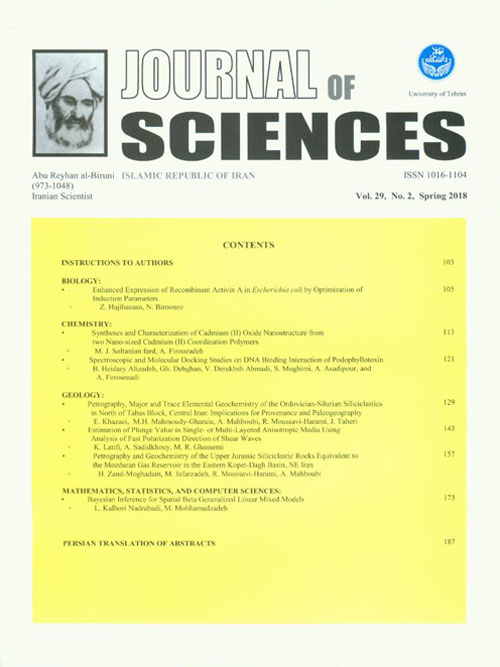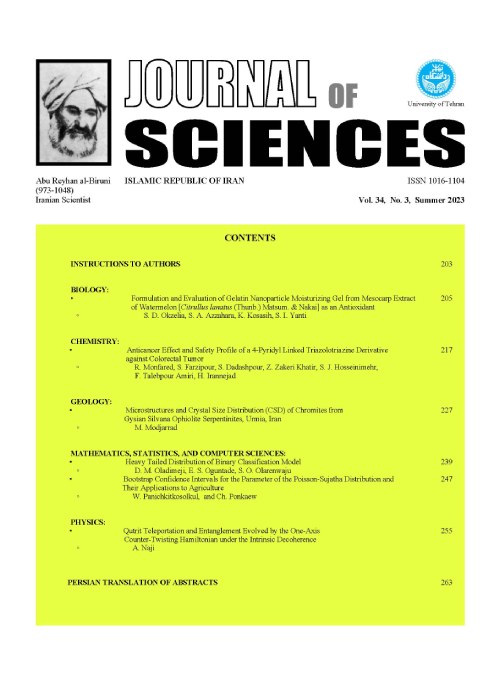فهرست مطالب

Journal of Sciences, Islamic Republic of Iran
Volume:29 Issue: 2, Spring 2018
- 98 صفحه،
- تاریخ انتشار: 1396/12/15
- تعداد عناوین: 7
-
-
صفحات 121-127
-
صفحات 173-185
-
Pages 105-111Activin A is a member of the transforming growth factor β super family. Because of its extensive clinical usages, its recombinant production is beneficial. In this study, activin A was expressed in E. coli using the pET 21a expression vector. The optimization of the activin A production in E. coli was done by using the response surface methodology (RSM). At this stage, the effect of IPTG and lactose concentration as inducers on protein production was investigated. The effect of different post-induction time and temperature on protein production was then studied in two strains of E. coli (BL21(DE3) and BL21(DE3) plysS). For enhanced expression, the optimum IPTG and lactose concentrations were 1.5 mM and 0% W/V respectively. In the DE3 strain, the optimum post-induction time and temperature were 10 hours and 30°C respectively while in DE3 (plysS) these were 4 hours and 35°C respectively .Keywords: Activin A, E. coli, RSM, Lactose, IPTG
-
Pages 113-119Two nano-sized mixed-ligand Cd (II) coordination polymers; [Cd (4,4' -bpy) (C4H4O4)].1/4 H2O (1) and[Cd(bpy)1.5 (NO3)2].3H2O (2) (bpy=bipiridine) were synthesized by a sonochemical method and characterized by elemental analyses, thermal gravimetric analysis (TGA), differential thermal analysis (DTA), scanning electron microscopy (SEM) and Fourier transform infrared spectroscopy (FT-IR). The crystallinity of these compounds were studied by Powder X-ray diffraction (XRD). CdO nanostructures were obtained by direct calcinations of nano polymers at 400 oC. The cadmium (II) oxidenano-particles were characterized by Powder X-ray diffraction (XRD) and scanning electron microscopy (SEM).Keywords: Coordination polymer, CdO, Nanostructure, Calcination
-
Pages 121-127The binding interaction of novel podophyllotoxin derivative, (3R,4R)-4-((benzo[d][1,3]dioxol-5-yl)methyl)-dihydro-3-(hydroxy(3,4-dimethoxyphenyl) methyl) furan-2(3H)-one (PPT), with calf thymus DNA (ctDNA) has been examined using UV-Visible absorption spectrophotometry, fluorescence spectroscopy, viscosity measurement and molecular docking studies. UV-Vis absorption results showed hyperchromic effect and low binding constant value (1.01×104 M-1), indicating non-intercalative interaction as a binding mode. The competitive fluorescence study also confirmed the obtained results from UV-Vis absorption spectra. Small changes in the viscosity of DNA exhibited that the interaction of PPT with DNA is based on groove binding mode. Molecular docking study showed minor groove interaction and -7.08 kcal/mol as a calculated energy.Keywords: Spectroscopy, Podophyllotoxin, DNA, Ccompetitive fluorescence, Groove binding
-
Pages 129-142The upper part of Shirgesht (UPS) and lower part of Niur (LPN) formations (Ordovician-Silurian) consist of sandstone, shale and limestone, respectively. The petrography and geochemical analysis conducted to evaluate provenance of siliciclastic deposits in order to understand the paleogeography of Central Iran during the Early Paleozoic time. This study shows that quartz and K-feldspar are the most abundant minerals in these siliciclastic rocks and the felsic igneous rock, probably granite, is the possible source rock. The average CIA (71) value and rare earth elements diagram, such as Th/U ratio versus Th, reveal a high degree of paleo-weathering in the source area. The craton interior and transitional continent were interpreted as a tectonic setting for UPS and LPN formations, respectively. Furthermore, the geochemical analysis revealed active continental margin and mostly passive margin during deposition of these two formations, respectively. Rifting in Central Iran during Ordovician-Silurian time generated normal faults at the edge of platform which had a major role in production of siliciclastic deposits.Keywords: Shirgesht, Niur formations, Provenance, Petrography, Geochemistry, Tectonic setting
-
Pages 143-156Estimation of the fast polarization direction of shear seismic waves that deviate from horizontal axis is a valuable approach to investigate the characteristics of the lower crust and uppermost mantle structures. The lattice preferred orientation of crystals, which is generally parallel to the downward or upward flow of the mantle or crust, is an important reason for the occurrence of fast axis plunge in these structures. We introduce a new method to estimate the plunge and the true percent of anisotropy. To evaluate the accuracy of the method, we applied it to back azimuthal synthetic receiver functions produced by the Raysum code. The output resulted from this new method (including plunge and percent of anisotropy) were compared with inputs of Raysum code, and reveal that there is a very good coherence among the inputs and output values estimated by our method. This method has been applied to anisotropy analysis beneath two different stations of SHGR in Iran and MOX in Germany. The splitting parameters beneath the SHGR station, are estimated to be φ=60±1 degrees and δt=0.54±0.02 sec. The plunge value and percentage of anisotropy in SHGR are estimated to be 45±0.5 degrees and 4 percent, which can correspond to an old flow in a subduction zone within the area. The splitting parameters in the crust beneath the MOX station, are estimated as φ=98±2 degrees and δt=0.38±0.02 sec. The plunge value and percentage of anisotropy in the crust of the MOX are estimated 45±0.2 degrees and 5.5%.Keywords: Anisotropy, Fast polarization direction, Fast axis plunge estimation, Shear wave splitting, Receiver functions
-
Pages 157-171In this research, petrographic and geochemical (major and trace elements) characteristics of siliciclastic rocks of the Mozduran Formation in the eastern Kopet-Dagh Basin have been carried out in order to reveal their provenance such as source area paleoweathering, parent rock composition and tectonic setting. Mozduran Formation is mainly composed of limestone and dolomite, with minor amounts of siliciclastic rocks and evaporites. Siliciclastics rocks (sandstone and shale) of Mozduran Formation are mainly present in the easternmost parts of the Kopet-Dagh Basin. Four stratigraphic sections of Mozduran Formation, namely Kole-Malekabad, Kale-Karab, Deraz-Ab and Karizak, were measured and sampled in the SE of the basin. Petrographic investigation showed that the sandstones are mostly classifies as litharenite and feldspathic litharenite. Geochemical data revealed that CIA values of Mozduran siliciclastic rocks confirm a medium weathering that can be due to semi-arid climatic condition in the source area. Felsic composition of parent rocks and quatzolithic petrofacies of Mozduran Formation sandstones and their constituents such as Qp, Qm, Ls, Lm and F, together with paleocurrent analysis show that these siliciclastic sediments may have derived from uplifted and trusted belt of sedimentary or sedimentary- metamorphic rocks of south Mashhad and metamorphic rocks of north Fariman region. Petrographic and geochemical analyses suggest that these sediments deposited in a continental rifting system.Keywords: Provenance, Siliciclastic, Geochemistry, Mozduran formation, Kopet, Dagh basin
-
Pages 173-185
In some applications, the response variable assumes values in the unit interval. The standard linear regression model is not appropriate for modelling this type of data because the normality assumption is not met. Alternatively, the beta regression model has been introduced to analyze such observations. A beta distribution represents a flexible density family on (0, 1) interval that covers symmetric and skewed families. In this paper, a beta generalized linear mixed model with spatial random effect is proposed emphasizing on small values of the spatial range parameter and small sample sizes. Then some models with both fixed and varying precision parameter and different combinations of priors and sample sizes are discussed. Next, the Bayesian estimation of the model parameters is evaluated in an intensive simulation study. Selected priors improved the Bayesian estimation of the parameters, especially for small sample sizes and small values of range parameter. Finally, an application of the proposed model on data provided by Household Income and Expenditure Survey (HIES) of Tehran city is presented.
Keywords: Bayesian estimation, Beta regression model, Household income, expenditure data, Spatial random effect


